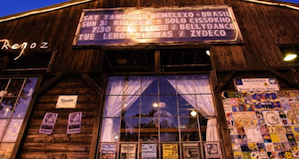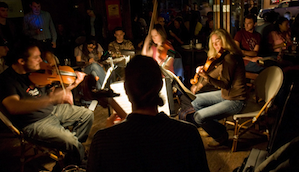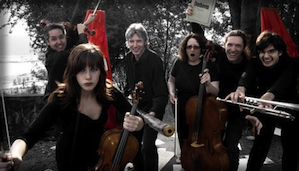
The crowd whooped and hollered as a punk rocker named Coco Cobra, barely attired in fishnet stockings, platform boots, and black leather jacket, belted out the Queen of the Night’s famous aria from Mozart’s opera The Magic Flute. She was accompanied by a motley orchestra of various strings and electric guitar, the latter wielded by a Mozart-bewigged and -beshaded axman who turned out to be the leader of one of Oregon’s more-important classical music institutions.
That was the climactic scene at the summer showcase concert that culminated Classical Revolution’s second annual, national conference in Portland, Oregon, in June. It showed off the plucky movement’s irreverent, yet respectful, approach to classical music (the slinky Ms. Cobra, actually a member of the female classical vocal trio Bergerette, nailed the famously demanding aria), as did the fact that it happened in a rock/cabaret club instead of a traditional classical concert hall.
But what went on behind the scenes at the conference itself might have been more significant. Ten directors from Classical Revolution chapters met to exchange ideas and plan the revolution’s next phase. They shared success stories and concert models, fund-raising strategies and outreach endeavors, and more.
Mission Statement
In its seven-year history, Classical Revolution has averaged between 120 and 150 public events per year in the Bay Area alone, featuring over 800 different musicians in more than 100 venues, according to CR founder Charith Premawardhana.
“We want to play for everybody. Everybody deserves to have really good music, regardless of background or income bracket.” – Founder Charith Premawardhana
The jams at Revolution Cafe often start off with a small ensemble and grow as more musicians arrive, drawing from a base of 20 to 30 regulars, most of them “local freelancers, and amateur musicians who are passionate about chamber music and have played their whole lives, who use CR as their outlet for music making and networking with other musicians,” he says. Sometimes members of the San Francisco Symphony, Opera, and Ballet orchestras; touring musicians; and members of established local classical music groups participate, as well.
Groups will try out new material or play a few pieces from upcoming gigs at the chamber jam events, but usually the music is chosen from the standard repertoire, and musicians show up and read down the standards, as happens at jazz jam-sessions. “The musicians can perform the music confidently,” Premawardhana says, “reading stuff we know well and offering a fresh and spontaneous performance to our audience.”

When the patio is open, the crowd can swell to 70 to 100 audience members on average, many of them in their 20s and 30s (which is fairly rare for classical music events) and from diverse ethnicities and economic brackets, he says.
Classical Revolution has collaborated with other organizations like the Monterey and Napa Valley symphonies, Music in the Mountains, and Carmel Bach Festival, and has staged events at schools, juvenile detention centers, and various community organizations, including a music festival to show support for, and raise awareness of, the Occupy movement. “It’s nice to be involved with different groups,” Premawardhana says. “We want to play for everybody. Everybody deserves to have really good music, regardless of background or income bracket.
“I’ve wanted to have a very broad approach and include many kinds of activities,” Premawardhana says. “San Francisco has such a breadth of music from different styles, and we are in a position where a lot of people know about Classical Revolution locally and go to us when they need strings and orchestral musicians for their projects. San Francisco is a great place to have as a headquarters, since there is such a strong community of musicians — chamber musicians and otherwise — and we have been able to cultivate a great base of operations.”
Since its 2006 birth in San Francisco, the revolution has spread to more than 40 cities around the world.
Since its 2006 birth in San Francisco, the revolution has spread to more than 40 cities around the world, with interest now coming from Saint Louis, San Diego, and Jacksonville. “Classical Revolution is very much part of what California is all about,” says Premawardhana, who recently traveled to perform with CR directors from Detroit and Baltimore. “So many ideas started in the Bay Area and spread out around the world. We’re just a part of that.”
Common Vision, Separate Paths
Former San Francisco Conservatory viola student Mattie Kaiser, who jammed with CR’s original players early on, founded Portland’s chapter a few months later and has visited chapters in half a dozen cities. She notes that “they’re all run by the same type of person who really just believes in the value of chamber music and the community it builds, even though it manifests in different types of shows.”

She also perceives a trend toward rising performance quality in the more-established chapters. “The more musicians who hear of us and who get involved, the more we have to pick from when we do a programmed concert” (as distinct from a jam session), she explains. That translates into more-professional ensembles and high-level soloists.
Kaiser, who attended both national conferences, believes the most valuable element that CR chapters share is the relationships they create among working musicians and presenters. “The most amazing thing that comes out of Classical Revolution is the network,” she says. “I have hundreds if not thousands of connections all over the world because of this network. I can bounce around the globe and have people to play music with.” The skills she learned in founding and running CR Portland also helped her get her new job at New York’s classical music management agency Opus 3 Artists.
Yet, for all their shared values — the chapters all subscribe to the essential CR tenet of bringing chamber music to more people by performing it in unusual (for classical music), often-informal venues — the national conference showcased some of their diverging approaches.
“Classical Revolution means something different to each individual,” Premawardhana says. “In San Francisco, we’re focusing on new music and education programming, working with hip-hop and rock musicians, dancers, poets, spoken words. But now, with so many people involved in different capacities, everyone has a unique idea of what it is. It’s like an organism that’s growing and living, with people continually joining and being involved.”
“We’re moving toward an open forum rather than dictating that ‘Classical Revolution should look like this everywhere.’” – Mike Hsu
The Portland chapters and (soon) the San Francisco chapter, for example, are nonprofit organizations that hold periodic fund-raisers and do public outreach as part of their nonprofit mission. Phoenix’s group, by contrast, is a for-profit entity supported by a Tempe museum. “They’re in a sense freer by not having to worry about the bottom line, but at the same time, they’re tied to the history museum’s mission,” CR Portland’s Mike Hsu explained.

Phoenix and Chicago have also innovated in audience outreach efforts, including “instrumental petting zoos,” incorporating food trucks at outdoor events, and so on. Richmond’s chapter hosted an event that paired music related to the Civil War (by Charles Ives, Stephen Foster, and others) with local writers’ readings of their Civil War–themed poetry and prose. And Chicago’s chapter even brought musicians from Egypt for an “East meets West” concert.
Portland’s chapter started with the “chamber jam” model of readings (often unrehearsed) of classics at a northeast Portland neighborhood cafe, and gradually added special events such as Halloween’s fully staged “Decomposers Night” at a theater, and “Bachxing Day” on Dec. 26. The monthly classical jams at the Waypost are almost always packed with 50 to 75 attendees who generally look a lot younger and more “alternative” than the typical classical music audience, though musicians and audience members of varying ages, demographics, and aptitudes (including some of the city’s finest musicians) do attend.
Since Christopher Corbell took over from Kaiser, Portland’s chapter has added two more monthly jams (in various neighborhoods) to the original Waypost location, “including an afternoon jam encouraging family and youth to get the same fun out of classical music that their peers are getting with indie rock, hip-hop, etc.,” says longtime CR Portland member and violinist Virginia Feldman.
At the national conference, the assembled directors regarded this diversity and constant evolution as a strength. “We agreed each chapter has its own model that’s going to work differently because of the different local culture and arts organizations in each particular city,” Hsu said. “That’s why we’re moving toward an open forum rather than dictating that ‘Classical Revolution should look like this everywhere.’”
Open Source
Hsu was referring to another hot topic on the agenda. Although groups at Classical Revolution’s stage of development often move toward uniformity, hierarchy, maybe even establishing a governing body, some tension emerged at last year’s meeting in which several members resisted such a direction, including attempts to forge a licensing agreement for use of the CR name. This summer, the directors seem to be embracing Corbell’s proposal to create an open-source platform, hosted at FreeClassical.org, which will allow the various chapters to share arrangements, fund-raising and promotional strategies, concert ideas, and more on an ongoing basis, not just at these annual meetings.
“A lot of these chapters just started in the last year or two, and they’re already building a huge following.” –Hsu
“The second Classical Revolution conference delivered the biggest thing on my wish list,” Corbell says. “I’m really happy that we were able to move away from insular, private communication and organizing toward a very transparent, open-source, ‘bazaar’ model. We are in the early days of a soft launch of a website where the conference attendees will be trying out online boards, catching any configuration bugs and starting a few early discussions. Once the beta period is over, the site will be opened up to anyone who wants to collaborate and contribute to the movement — any individual or ensemble or organization.”
For now, at least, Classical Revolution seems to be operating more like the first American confederation than like the constitutional government that succeeded it, but with much more cooperation. In that sense, it’s true to its origins. In a paper delivered in a conference called “Musicology and the Present” at Portland’s Lewis & Clark College last spring, Stanford University musicology doctoral candidate Nate Sloan drew an analogy between CR’s diverse, localized approach and Silicon Valley’s creative startup culture, contrasting both with the older, big-corporate institutions that produced mid-20th-century industrial conglomerates and big-city classical music institutions like symphony orchestras and opera companies.
“Classical Revolution is redrawing a centuries-old map of the musical city,” the paper’s synopsis reads. “Rather than classical music emanating from one sole beacon, the concert hall, a decentralized, rhizomic network of ‘serious sound’ emerges throughout the city. That such geography mirrors recent trends in urban planning and theory is no coincidence: San Francisco is a city highly conscious of living with the tragic results of monumental mid-century urban renewal and ‘Manhattanization’ projects.”
Judging by the discussion at this summer’s national CR conference, the decentralized model applies to the national movement, as well. Hsu came away with an encouraging impression of the state of the revolution. “It’s very alive and growing very fast,” he says. “A lot of these chapters just started in the last year or two, and they’re already building a huge following and showing a huge commitment to it. It was so inspiring to see so many people who are just scraping by as musicians still dedicating their lives to bringing classical music to the community.”
For his part, Premawardhana intends to continue “my role as artistic director for our Bay Area programming, while having freedom to travel to play and work in other regions,” he says. “I want to help touring ensembles and musicians link up with Classical Revolution chapters,” which benefits the chapters by infusing the CR events with new music and varied voices, while helping ensembles spread their music.
Economics of Outreach
Both Kaiser and Premawardhana have noticed the wider classical music world’s taking note of CR’s ideas in their eternal quest to lure younger audiences. The San Francisco Symphony’s After Hours events is but one example. And both remain optimistic about the revolution’s future. But they caution that CR’s independent, low-budget, no-frills model hasn’t provided a model for building a career or making a living in classical music.
“People who are within the mainstream classical music industry now have an understanding that the stodginess of classical music presentation for the last 100 years or so has to change.” – Mattie Kaiser
“Music, in general, is having a crisis in musicians’ getting paid for making music. A lot of really creative individuals and ensembles are putting a ton of work into figuring that out, but we’re not at that point of sustainability right now,” says Kaiser, who, like Corbell, served as a volunteer at CR Portland. “[Corbell] is making a hard push to make sure that musicians are paid for their work, to make sure we're not just using the resources of young active energetic people but that it is sustainable to them. Being a director exhausting, and it doesn't pay. In general, the more established CR groups are finding ways to pay their performers for programmed shows, and maybe we’ll get to the point where we can pay a salary to a director, but none of our organizations are at that point yet.”
Premawardhana says that the revolution has already achieved its principal goal. “I was making an income playing in orchestras around the Bay Area. The musicians were diverse — older people, younger people, different races — but I saw an audience that was all old, white, and rich. That’s what I wanted to change. That’s what CR has been able to fulfill: I’m able to play music I really feel passionate about for my peers and as many people as possible, and I want to keep doing that.”
Kaiser thinks the movement’s greatest impact lies ahead. “Five years ago, I didn’t think it was going to have this kind of effect nationally, globally, at all levels of classical music performance. I’m optimistic. People who are within the mainstream classical music industry now have an understanding that the stodginess of classical music presentation for the last 100 years or so has to change.” Thanks in part to Classical Revolution, “everybody is aware of this now, and I’m pretty excited to see where it’s going to go.”
